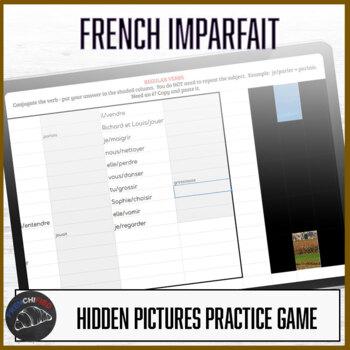TPT products
Teaching the passé composé and imparfait
Table of Contents
Teaching the passé composé and imparfait is something that is challenging for many French teachers. And guess what? It’s that time of year again – the time when French teachers are trying to get their students’ heads wrapped around the concept of two different past tenses. Some will get the concept pretty easily, but others will need a LOT more help. Here are some of the ways I teach my students the two tenses and the difference between them.
The passé composé
Most of my students come to me already speaking Spanish. Usually, this is a great asset as their Spanish knowledge can be used to learn French. Sadly, this is not the case with the passé composé! The Spanish equivalent does not use a helping verb, so it’s a new concept to them.
When I start explaining the PC to them, I tell them that there are two verbs involved because there are two pieces of information: the when and the what. The helping verb is the when part – it tells me when the action took place (in the past!). The past participle is the what part – it tells me what action took place. Without both parts, it is impossible to know what the person is saying – I know that something happened in the past, but not what happened. Or, I know what happened – but not when. So you definitely need both parts!
When we practice the PC – whether in ready or writing – I have them underline the helping verb and circle the past participle. Whatever the task, before they turn it in to me I ask them to go back and underline/circle those two things – and if they have a sentence that doesn’t have one thing underlined and one thing circled, they’ve made a mistake and need to fix it.
Teaching the passé composé and imparfait
The imparfait is pretty simple as far as conjugations go. It’s the idea of how to translate it and when to use it that gives students trouble. I have used the typical mnemonic devices for remembering which one to use (SIMBA CHEATED, etc). As mentioned above, most of my students already speak Spanish so this is a piece of cake for them. But for the ones who don’t, it takes a lot of time and practice.
One thing I use is the movie synopsis example. I pick a movie that most of them have seen – superhero movies, Titanic, the Lion King, etc. Then we talk about the different things you could say about the movie. I tell them about the movie only using things that would be in the imparfait – then we talk about what kind of information I included. Then I tell them the actual plot synopsis of the movie and we discuss why those things need to be in the PC.
I do a couple more examples using different movies, then I have them come up with their own for a movie of their choice. This is all done in English, so they aren’t worried about verb conjugations or vocabulary. Once they are feeling comfortable, this is when we start writing sentences in French.
Things I use to teach the passé composé and imparfait
I have quite a few different things that I’ve found helpful in practicing the passé composé and imparfait. Conjuguemos is of course a favorite, as well as Gimkit. Gimkit allows for text input, so you can force students to type in their responses or you can choose multiple choice, depending upon what exactly you want to practice. I have also used Boom cards and an excellent series of packets by Mme R’s French resources – she has an imparfait bundle and a passé composé bundle with guided notes and practice activities.
For reading practice, I have a passé composé and imparfait activity about Sidney Crosby. My students aren’t big hockey fans, though – so I don’t get to use this one as much. Sometimes we read les Zombies Attaquent, which has an imparfait/PC version as well as one that uses the passé simple in case I want to use it in 3rd/4th year. For passé composé, we play the digital escape game Prisoner in the Bastille. It has students choosing the correct forms of verbs, past participles, and it is quite challenging (but fun!).
When we are ready to do the imparfait, I have them do hidden pictures activities (drill and kill, but it’s self-grading so they enjoy making the picture appear). I have a couple of digital games that they play – one is a simple choice game where they see an English sentence and choose which tense it would be in French. At the end of the unit, we play another digital escape game, Perdu au Louvre.
What I’ve learned over the years
The one thing I’ve learned over the 28 years I’ve been teaching is that this is a tough concept and it takes students a long time to get it. No matter how much practice, some will just not internalize it for a long time. I’ve seen so many students who “kind of” got it at the end of 2nd year – but then came back for 3rd year and somehow they had figured it out! So maybe it just takes mental processing time.












